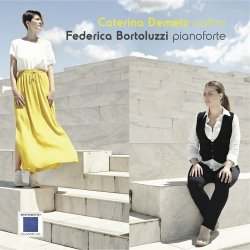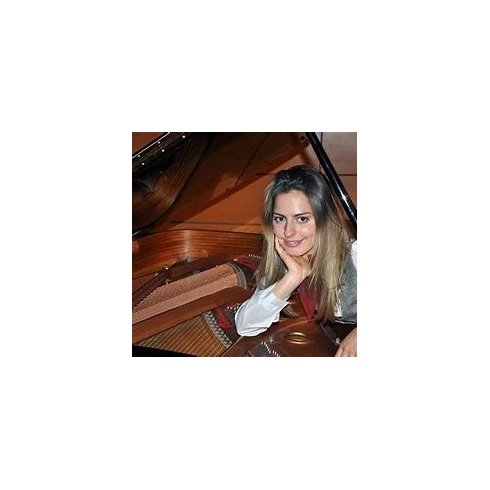

The offìcial catalogue of Mozart's compositions include more than forty works for piano and violin, two thirds of which need to be excluded immediately as there are either doubts as to their authenticity, are mere fragments or for flute as an alternative to the violin, a common practice during the 1760's when the geme was stili at an experimental stage (KV 6-15, composed by Wolfgang between 6 and 8 years old). 1hen there are six (KV 26-31) which are often not taken much into consideration by academics as they are a «synthesis between the galante style with sturmisch influences» (Claudio Bolzan) where the German adjective refers to the preromantic atmosphere of the time. At the end of the day the "officiai'' works are made up of fifteen Sonatas from 301 (1778) to 547 (1788)
The four recorded here are from a particularly lively period in Mozart's creative output while on a persona! leve! it was one of the most troubled. 1hey were the last years Mozart spent in Salzburg in an increasingly problematic climate which led to his permanent move to Vienna. Each Sonata was written in a different city, proof of an unsetded existence: 304 in Paris (1778), 305 in Mannheim (1778),
378 in Salzburg (1779), 379 in Vienna (1781).
The first two are part of a set of six which were finished whilsc staying between che German city and che French capitai, it was here chat chey were published and dedicated to Princess Maria Elisabech Electress of Palatinato. Sonata 304 is che only - both in chis set and indeed of ali che sonatas - in a minor key, as is Sonata 310 far piano which was composed in Paris during the same period, spring-summer 1778, bue which has two movements and not three. 1hey share che same dark, somber colour, despite this Mozart never slips into cragic tones. Tue opening Allegro begins with che theme exposed on both instruments in octaves, which is then presented three times by the violin, each time with a differ ent piano accompaniment; the most striking section is the development with its counterpoint. Tue Tempo di Menuetto which follows has nothing of the character of a dance, shrouded by a melancholic veil which only the Trio middle section briefly manages to lift.
Sonata 305 is also in two movements, but has a completely different character; constructed on a perfect balance between the two instruments, it opens with an Allegro di molto in a carefree 6/8 which hints of a baroque gigue, but the frequent unisons and crescendos piace it within the modem style of Mannheim. Once again there is exquisite counterpoint in the middle section. Tue second and fìnal movement is no less refìned, an Andante grazioso made up of a theme followed by six elegant variations, the fìrst of which is presented by the piano.
Sonata 378 is the only one of the four to have the classic three movements and dates from the fìrst months of 1779 when Mozart got back to Salzburg after stop ping in Strasburg, Mannheim and Munich on his way back from Paris. Together with Sonata 379 it makes part of the set of six Sonatas dedicated to his pupi! Josephine Auernhammer who must have been an excellent pianist, as a few years later she was to play scores for piano four hands with him. Tue opening Allegro moderato, unusually long for that time (almost 200 bars), is characterized by the presence of at least four themes with the lightness which makes Mozart's music unmistakable. Tue middle Andante sostenuto e cantabile evokes preromantic so norities in the violin part, underpinned by the piano, while the Rondeau takes the time of a gigue. Tue closing Allegro is lively and playful.
Sonata 379 has an unusual form, again in two movements it opens with an Adagio in G major which shifts to an Allegro in G minor. Tue contrast could not be stronger but it all happens with Mozart's usual naturalness. Tue score comes to a dose with an Andantino cantabile followed by fìve variations in which the restlessness of the Allegro is quelled, even though every now and again one has the sensation that "something" is still agitated beneath the surface. Bur the closing bars sweep aside every tension.


Caterina Demetz
he began studying violin at the age of 4 and piano at the age of 5 at the Milan Conservatory, where in 2006 he graduated with full marks, honors and mention in both instruments; in 2012 he then obtained a specialist degree in violin.He studied with illustrious violinists and pianists, including Shlomo Mintz, Massimo Quarta, Domenico Nordio, Klaidi Sahatci, Sarah Nemtanu, Aldo Ciccolini, Angela Hewitt, Paolo Bordoni and from 2008 to 2011 with Salvatore Accardo at the Walter Stauffer Academy in Cremona. From 2007 to 2013 he obtained several prizes, such as the "Giulio Forziati" for the young talents of the Milan Conservatory, in trio the first absolute prize of the "Beltrami Prize" for chamber music, with subsequent invitation to perform live on the Radio Vaticana and the "Pina Carmirelli" prize. From 2009 to 2012 he collaborated with the Italian Chamber Orchestra, with the Mozart Orchestra of Claudio Abbado, the Filarmonica della Scala, the Haydn Orchestra of Bolzano and Trento.
Between 2010 and 2012 he held solo concerts for violin and piano in Italy and abroad, at the Italian Cultural Institute in New York, Barcelona and Tirana and toured Japan with the Reale Concerto Ensemble. Since 2012 he has been a violin in a row at the Filarmonica Arturo Toscanini in Parma. In 2014 he took part in the Rai Radio3 program “Spazio Verdi”.

Federica Bortoluzzi
Born in Milan in 1988 in a family of musicians, she began studying the piano under the guidance of Alberto Colombo at the age of six. He perfected the study of the piano with Andrea Lucchesini and Maria Tipo, through whom he learned and shared a research and thought that marked his musical growth.
At the age of 13 she gave a recital for the Season at the Playhouse in Vancouver, Canada, starting her first Masterclass, in collaboration with the Tom Lee Academy, an event that distinguished her by awarding her the merit from the House of Commons of Canada. In his concert career he has given concerts for organizations such as La Società dei Concerti in Milan, La Verdi in Milan, La Società Filarmonica in Rovereto, Fondazione Teatro Grande in Brescia,
abroad in Greece in Lefkada and kythira, in Portugal at the National Theatre of Coimbra, in Austria at the concert hall of the Mozarteum in Salzburg, in Switzerland in the Auditorium of the Lugano Conservatory. In addition to his solo activity, he also dedicates himself to chamber music, a musical expression to which he devotes particular attention in the piano duo with the Pianist Giovanni Nesi, in the duo with the violinist Caterina Demetz, e in diverse altre formazioni. Come musicista è molto apprezzata per la genuinità e chiarezza delle sue interpretazioni anche da musicisti e personalità di chiara fama come A.Ciccolini, C.Katsaris, J.P.Luisada, V.Askenazy, J.Biegel, Bruno Canino.
He participated in numerous competitions, winning in 2014 the second Prize and Special Audience Prize at the prestigious International Piano Competition "Rina Sala Gallo" in Monza; among the various awards we remember the "M. Zana" Award 2011 for the best interpreter of pieces by Franz Liszt, as part of the Competition "National Prize of the Arts 2011 (AFAM) , “Camillo Togni di Brescia”. Ha registrato per “Radio Classica” musiche di F.Chopin per la trasmissione “Il Pianista”.Ha suonato in diretta radiofonica a Rai Radio3 alla trasmissione condatta da Oreste Bossini “La stanza della Musica”, in duo con il pianista Giovanni Nesi. Insegna Pianoforte Principale all'Istituto Superiore di Studi Musicali "P.Mascagni" di Livorno.
